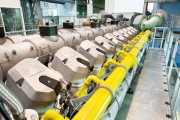
The 20V35/44G engine on the MAN Diesel & Turbo test bed in Augsburg, Germany |
MAN Diesel & Turbo recently showcased its new range of gas engines and turbines at its Augsburg facility, including the 35/44G engine, the latest addition to its four-stroke power portfolio.
The newly developed Otto gas engine has an electrical efficiency of 47.2%, and is available for combined heat and power (CHP) and/or jointly with an MAN steam turbine of the MARC series.
It features a single-stage turbocharger with variable turbine area (VTA) technology and many innovative technological elements, the engine manufacturer said. The spark-ignited unit, which is said to be ideal for combined cycle and combined-heat and power configuration with waste-heat utilisation, has been developed to comply with all current emission limits solely by in-engine measures.
Power densityThe 35/44G is offered in a V-type version with 20 cylinders and an output of 10,600 kW (10,200 kW). Its rated outputs – 530 kW per cylinder for 50 Hz power generation and 510 kW for 60 Hz power generation – give the 35/44G best-in-class power density among gas engines, MAN noted.
FuelIn addition to a high supply reliability and the potential for savings in terms of operating and procurement costs, the advantage of gas-fired power plants lies in extremely low emissions coupled with a high level of efficiency. Due to the lower carbon content of the fuel, gas engines emit around 25% less CO2 than diesel engines. NOx emissions are roughly 80% lower, while emissions of SOx, soot, and particles are virtually non-existent.
Lean-burn conceptIn a lean-burn gas engine, the mixture of air and gas in the cylinder is lean, that is, more air is present in the cylinder than is needed for complete combustion. With leaner combustion, the peak temperature is reduced and less NOx is produced, MAN said. Higher output can be reached while avoiding knocking and increasing efficiency.
Advanced ignition technologyThe ignition system comprises a capacitive discharge system and an ignition coil, which delivers the necessary high voltage via an ignition lead to the spark plug. To improve combustion, the spark plug is located in the pre-chamber.
Gas is precisely metered to the pre-chamber by means of a separate valve. In conjunction with the lean mixture from the main chamber, which is fed into the pre-chamber by the compression cycle, this creates a highly efficient, almost stoichiometric mixture. This is ignited using the spark plug, providing an ignition amplifier for the main chamber.
Safety and control systemThe 35/44G engine is equipped with the safety and control system SaCoSone, which guarantees reliable engine operation with an optimum operation range between knocking and misfiring. All cylinders are regulated individually.
Cogeneration or combined cycleIn addition to using thermal energy recovered from engine sources for heating or cooling in cogeneration or tri-generation applications, the exhaust heat of the 35/44G engine can be used to produce steam to drive a steam turbine generator. As a result, the overall output and efficiency of the power plant can be increased without additional fuel costs.